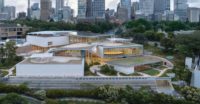In Los Angeles he had started a practice in the early 1990s focusing on small civic projects and private houses, and gained local renown for founding the A+D Museum with fellow architect Stephen Kanner. From this base, he began paving the way for his return. He started actively seeking projects in Ghana, and by 2005 he established his firm, Constructs, in its capital city, Accra, and in Tamale, the capital of the country’s northern region.Twenty years after leaving his native Ghana to attend the Architectural Association in London and then seek employment abroad, Joe Osae-Addo found himself contemplating a return to his homeland during a visit in 2000. The West African nation had just elected a new president, and Addo sensed a “democratic fervor” that had not existed before. “There was an atmosphere of optimism and euphoria, and I wanted to be part of it,” he says.
Addo’s approach to design combines advanced techniques with traditional materials and methods. His own house is decidedly Modern, but made of adobe and timber. For a conference center nearing completion in Tamale, Addo created two concrete-framed structures raised on pilotis that have adobe infill and operable glass louvers. The buildings are wrapped in bamboo slats, providing shade and evoking locally made baskets.
His firm is working on housing projects at both ends of the socioeconomic spectrum. It has completed the master plan for a $150 million mixed-used development in Accra, for which it is now designing two residential towers for affluent Ghanaians.
Conversely, Constructs is designing a new town for Salman Village, which sits on top of a deposit of gold reserves. Addo has proposed rammed-earth courtyard houses arranged in clusters around park spaces. The relocated town will have schools, a clinic, and civic buildings, and sustainable strategies will be deployed throughout the site. He hopes to parlay this experience into other affordable housing projects for salaried Ghanaians of modest means, such as civil servants. His firm is now negotiating with the teachers’ union and the judiciary service.
But designing buildings is only one facet of Addo’s oeuvre. The architect’s desire to improve the quality of life in his homeland has generated work at all scales, and in multiple design disciplines. For the government of Tamale, Constructs has developed a “branding and beautification” scheme that includes street signage and motorized vendor carts; a microfinancing initiative will allow the vendors, who are primarily women, to buy their carts and thereby provide them with financial independence.
Addo also has ventured into the development and manufacture of building products that rely on locally available raw materials. He is setting up a processing plant that will produce wall studs and laminated beams from bamboo, and he is part of a group of investors, which includes his longtime collaborator Kanner, that own the rights to manufacture and distribute a variant of pozzolana ash. The material, dubbed Pozzoghana, is made by firing clay with palm kernel shells, a waste product of palm oil production. In a typical concrete mix, Pozzoghana can be used to replace as much as a third of portland cement—a material that is imported into Ghana and requires tremendous amounts of energy to produce and transport.
For Addo, these efforts are business ventures. Yet he also hopes that they provide employment for Ghanaians while making construction more affordable. “We will never solve the housing problems of Africa if architects do not shift their concerns to the development of locally manufactured systems and materials that inform design and improve our way of life,” he says.
Addo sees no conflict between these entrepreneurial efforts and his architectural practice. “Working in Africa demands looking at needs on the ground and responding to them,” he says. Describing his current role as a “design socioeconomist,” he says, “I’ve had to come back [to Ghana] and reinvent myself.”













Post a comment to this article
Report Abusive Comment